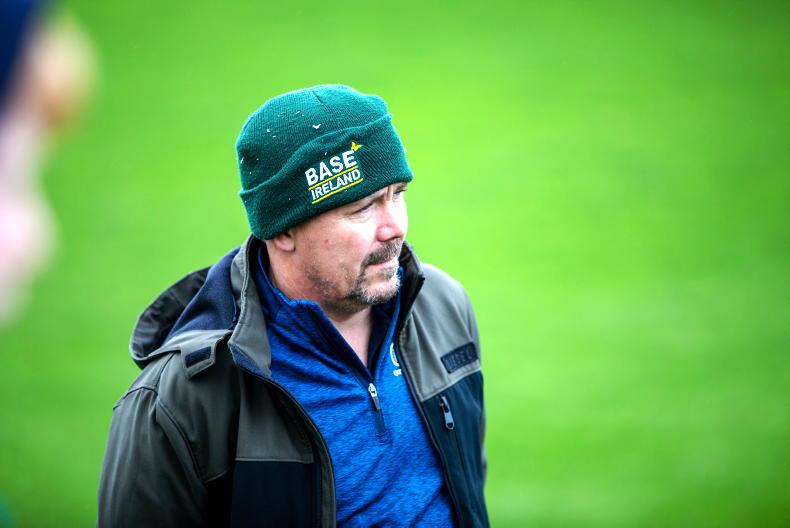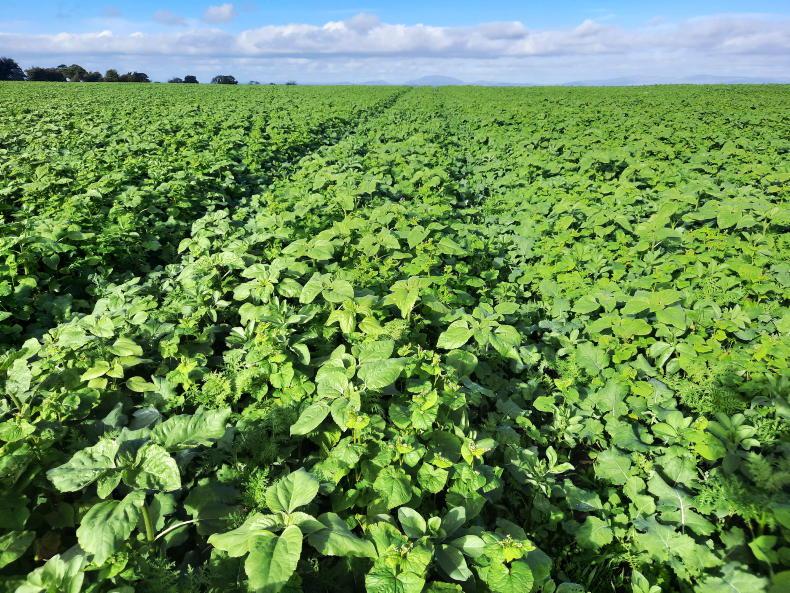From this week on, we will be profiling our Footprint Farmers. We will give a brief overview of their farm enterprises, what they are doing well and what they want to improve throughout the programme.
Gareth Culligan is the first farmer whom we visit. Gareth is a tillage farmer in Stabannan, Co Louth, farming owned, leased and rented ground. He grows a range of crops from cereals to oilseed rape and beans. As a member of BASE Ireland, he is taking a regenerative approach on his farm. He is focused on cover crops, companion crops, no-till practices, proper rotation, soil and leaf testing.
We visited the farm in Stabannan a few weeks ago and there was plenty to see.
A crop of oilseed rape had been planted, but it wasn’t your average crop. It was planted with companion crops including beans, phacelia, buckwheat, white clover and sunflowers.
The oilseed rape had established well and the companion crops add biodiversity to the soil. This is one of the key principles of regenerative agriculture.
The companion crops should be knocked back by the frost and allow the oilseed rape to break through. If weather and ground conditions suit, another option would be to graze the oilseed rape and companions.

Gareth Culligan is taking part in the Irish Farmers Journal's Footprint Farmers Programme which is supported my Macra's Agricultural Skillnet. / Claire Nash
Cover crops
Across the fields, Gareth has planted diverse cover crops.
In one field wheat, oats and linseed were spread with the fertiliser spreader and the drill followed with forage rape, phacelia, white mustard, buckwheat, sainfoin, chicory, white, red and berseem clover, oilseed radish and vetch, following a catch crop of spring beans.
The next field we visited had the same mix, but with a higher linseed content.
The weather was kind this season and Gareth has managed to get a cover on all but 20ac of land between winter crops and cover crops. The cover crops also went in early, allowing plants to get well established. This is important to protect the soil from erosion, keep living plants in the soil which take up nutrients which can be lost to water and keep more elements of the soil functioning in the winter months. A mixture of roots also helps with compaction issues.
He has planted a mixture of varieties in his winter cereals. He has been mixing varieties for a number of years and finds that the different levels of resistance to disease can slow down disease spread and reduce disease incidence in crops.
Taking a closer look at the soil
Gareth’s focus on the soil is clearly paying off as his soil test results are in really good shape. As part of the Footprint Farmers Programme, Gareth’s farm was sampled in the springtime.
The average pH of the soil is 6.7, while the majority of the soil is at index 4 for phosphorus and potassium. Gareth pays huge attention to other elements in the soil.
He knows magnesium and boron are low and he usually applies these elements in a liquid form.

A companion crop of oilseed rape, beans, sunflowers and phacelia in mid October on Gareth Culligan's farm in Co Louth.
What next?
Gareth will continue to build on the hard work he is putting into his soil. His aim is to become less reliant on chemicals.
He doesn’t necessarily want to farm organically as he thinks depending on the sector you’re in or the season that comes there will be a need for non-organic inputs at certain times.
As he improves his soil health, he is also increasing his carbon content and while he acknowledges that being paid for carbon storage is a long way off, he sees it as part of his business’s future as CAP payments reduce.
He said that Ireland should be able to sequester more carbon and get more credits [per hectare] than any other country in the world.
Integrating livestock into the farm
Over the next few years, Gareth plans to get more livestock on to the farm. He believes this will help his soil health and overall system.
He plans to get livestock farmers in to graze and if it is working out he might diversify into sheep on the farm. This would give him more control over grazing and it would bring grass into the rotation as well.
“Every farm is different. I’ve a lot to learn on how to grow clover,” he said.
Planning to improve carbon sequestration
Gareth said that while growing a diverse cover crop is doing great work in the soil, he wonders what happens when the soil growing the cover crop goes back into a monoculture cash crop. He wonders if we need to be mixing plants with different rooting depths to get carbon stored at different depths for carbon sequestration levels to improve. He has added chicory to his catch crops as it is deep-rooting.
Farm facts
Name: Gareth
Culligan.Farm type:
tillage.Farm size: 530ac.Focus: improving soil health and structure, reducing inputs, while maintaining profitability.Average soil test results
pH – 6.7.Phosphorus – Index 4.Potassium – Index 4.
From this week on, we will be profiling our Footprint Farmers. We will give a brief overview of their farm enterprises, what they are doing well and what they want to improve throughout the programme.
Gareth Culligan is the first farmer whom we visit. Gareth is a tillage farmer in Stabannan, Co Louth, farming owned, leased and rented ground. He grows a range of crops from cereals to oilseed rape and beans. As a member of BASE Ireland, he is taking a regenerative approach on his farm. He is focused on cover crops, companion crops, no-till practices, proper rotation, soil and leaf testing.
We visited the farm in Stabannan a few weeks ago and there was plenty to see.
A crop of oilseed rape had been planted, but it wasn’t your average crop. It was planted with companion crops including beans, phacelia, buckwheat, white clover and sunflowers.
The oilseed rape had established well and the companion crops add biodiversity to the soil. This is one of the key principles of regenerative agriculture.
The companion crops should be knocked back by the frost and allow the oilseed rape to break through. If weather and ground conditions suit, another option would be to graze the oilseed rape and companions.

Gareth Culligan is taking part in the Irish Farmers Journal's Footprint Farmers Programme which is supported my Macra's Agricultural Skillnet. / Claire Nash
Cover crops
Across the fields, Gareth has planted diverse cover crops.
In one field wheat, oats and linseed were spread with the fertiliser spreader and the drill followed with forage rape, phacelia, white mustard, buckwheat, sainfoin, chicory, white, red and berseem clover, oilseed radish and vetch, following a catch crop of spring beans.
The next field we visited had the same mix, but with a higher linseed content.
The weather was kind this season and Gareth has managed to get a cover on all but 20ac of land between winter crops and cover crops. The cover crops also went in early, allowing plants to get well established. This is important to protect the soil from erosion, keep living plants in the soil which take up nutrients which can be lost to water and keep more elements of the soil functioning in the winter months. A mixture of roots also helps with compaction issues.
He has planted a mixture of varieties in his winter cereals. He has been mixing varieties for a number of years and finds that the different levels of resistance to disease can slow down disease spread and reduce disease incidence in crops.
Taking a closer look at the soil
Gareth’s focus on the soil is clearly paying off as his soil test results are in really good shape. As part of the Footprint Farmers Programme, Gareth’s farm was sampled in the springtime.
The average pH of the soil is 6.7, while the majority of the soil is at index 4 for phosphorus and potassium. Gareth pays huge attention to other elements in the soil.
He knows magnesium and boron are low and he usually applies these elements in a liquid form.

A companion crop of oilseed rape, beans, sunflowers and phacelia in mid October on Gareth Culligan's farm in Co Louth.
What next?
Gareth will continue to build on the hard work he is putting into his soil. His aim is to become less reliant on chemicals.
He doesn’t necessarily want to farm organically as he thinks depending on the sector you’re in or the season that comes there will be a need for non-organic inputs at certain times.
As he improves his soil health, he is also increasing his carbon content and while he acknowledges that being paid for carbon storage is a long way off, he sees it as part of his business’s future as CAP payments reduce.
He said that Ireland should be able to sequester more carbon and get more credits [per hectare] than any other country in the world.
Integrating livestock into the farm
Over the next few years, Gareth plans to get more livestock on to the farm. He believes this will help his soil health and overall system.
He plans to get livestock farmers in to graze and if it is working out he might diversify into sheep on the farm. This would give him more control over grazing and it would bring grass into the rotation as well.
“Every farm is different. I’ve a lot to learn on how to grow clover,” he said.
Planning to improve carbon sequestration
Gareth said that while growing a diverse cover crop is doing great work in the soil, he wonders what happens when the soil growing the cover crop goes back into a monoculture cash crop. He wonders if we need to be mixing plants with different rooting depths to get carbon stored at different depths for carbon sequestration levels to improve. He has added chicory to his catch crops as it is deep-rooting.
Farm facts
Name: Gareth
Culligan.Farm type:
tillage.Farm size: 530ac.Focus: improving soil health and structure, reducing inputs, while maintaining profitability.Average soil test results
pH – 6.7.Phosphorus – Index 4.Potassium – Index 4. 







 This is a subscriber-only article
This is a subscriber-only article












SHARING OPTIONS: